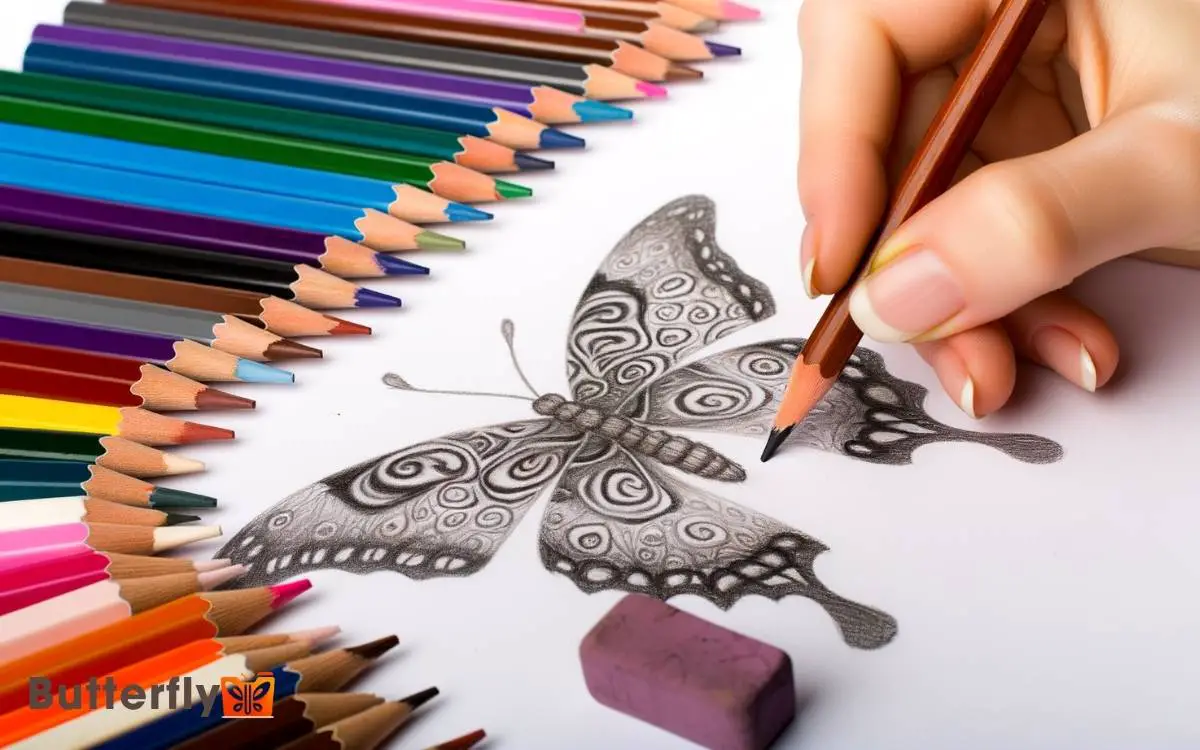How To Draw A 3d Butterfly? Step By Step Guide!
To draw a 3D butterfly, start by gathering high-quality pencils, a smooth thick paper, and colored pencils. Lightly sketch the butterfly’s symmetrical wings and body, using flowing curves for a natural shape.
Add intricate wing details like veins and patterns. For the body, sketch an elongated oval for the abdomen and a small circle for the head, adding textures and antennae. Introduce 3D elements by adding depth and shadows where the wings fold.
Use layering techniques and attach cut-out details for realism. Finish by shading and adding highlights with a white pencil. Ready for more details?

Key Takeaways
Gather Your Drawing Materials
Begin by collecting all the necessary drawing materials to make sure you have everything you need before you start. You’ll need a set of high-quality pencils, ranging from H to B for different shading effects. Grab a good eraser, one that won’t smudge your work.
Don’t forget paper preferably a smooth, thick kind that can handle detailed drawing. A ruler will help you maintain symmetry.
Colored pencils or markers will be essential for bringing your butterfly to life. Consider getting a blending stump for smooth shading shifts. Keep a sharpener handy to maintain precise lines. With these tools, you’re well-equipped to plunge into the creative process.
Now, let’s get ready to transform your ideas into a stunning 3D butterfly!
Sketch the Basic Outline
Start by lightly sketching the basic outline of the butterfly’s wings and body, ensuring symmetry from the center line. Draw a vertical line to mark the center of your butterfly. Next, refine the shape of the wings by adding gentle curves and smooth edges, making sure both sides remain balanced. Once the basic structure is complete, begin sketching patterns or markings on the wings to add detail and texture. If you’re looking for more tips on how to draw a butterfly, consider observing real butterflies or reference images for inspiration.
Next, sketch an oval for the body in the middle of this line. For the wings, draw two large, rounded triangles extending from the top of the body and two smaller, rounded triangles from the bottom. Make sure the wings are balanced and mirror each other on either side of the center line.
Use gentle, flowing curves to create a natural, dynamic shape. Don’t worry about perfection; this outline will guide the detailed work later. Keep your lines light and easy to adjust.
Add Wing Details
With the basic outline in place, let’s focus on adding intricate details to the butterfly’s wings to bring them to life.
Start by drawing the veins thin, curving lines extending from the base to the edges. These veins should branch out, creating a natural, organic pattern.
Next, add symmetrical patterns and shapes within each wing section. Think about circles, ovals, and teardrop shapes. Use varying sizes for a dynamic look. Don’t be afraid to include tiny dots or lines for extra texture.
Now, add shading to give depth. Shade lightly along the veins and the outer edges, gradually darkening towards the center. This creates a realistic, three-dimensional effect. Keep refining until you’re satisfied with the level of detail.
Create the Butterfly Body
Now, let’s focus on creating the butterfly’s body. Start by sketching the basic shapes: an elongated oval for the abdomen and a smaller circle for the head.
Once you’ve got the shapes in place, add detailed textures to bring your butterfly to life, using fine lines to mimic the natural patterns.
Sketch Basic Body Shapes
Begin by drawing an elongated oval shape to represent the butterfly’s body. This will form the central axis of your 3D butterfly.
Next, sketch a small circle at the top for the head. Make sure the proportions between the head and body look natural.
Then, draw two thin, curved lines extending from the head for antennae. These lines should have a slight curve to mimic the graceful nature of a butterfly.
For the wings, draw two large, teardrop shapes on each side of the body. The top wings should be larger and more prominent, while the bottom wings should be smaller. Remember, symmetry is key.
You’ve now created the foundational shapes for your butterfly. Great job! Let’s move on to adding intricate details.
Add Detailed Textures
Let’s enhance the butterfly’s body by adding detailed textures that bring it to life. Start by focusing on the head: sketch tiny, overlapping circles to mimic the natural segmentation.
Next, draw fine, curved lines along the thorax to create a subtle, ribbed texture. Use short, wispy strokes to outline the fuzzy appearance of the abdomen.
Don’t forget the legs; add thin, segmented lines to give them a realistic insect-like quality.
To add depth, gently shade the areas where the body curves inward, using a soft pencil or blending tool. This will create a convincing 3D effect.
Introduce 3D Elements
To make your butterfly truly pop off the page, start by adding depth and shadows where the wings overlap and fold.
Use layering techniques to create a sense of realism, making each part of the butterfly appear at different distances.
With these steps, you’ll transform your drawing into a stunning 3D masterpiece.
Adding Depth and Shadows
Adding depth and shadows is essential to make your butterfly appear as if it’s about to flutter off the page. Start by identifying the light source in your drawing. Imagine where the light hits the butterfly and where shadows naturally fall.
Use a soft pencil to lightly shade areas beneath the wings and body. Gradually darken these shadows, maintaining a smooth shift between light and dark.
To enhance depth, add subtle shading to the butterfly’s wings, emphasizing curves and creases. Blend the edges of your shadows to avoid harsh lines, creating a more realistic look.
Don’t forget to add a shadow beneath the butterfly on the surface it’s sitting on. This step will truly make your butterfly pop and give it that 3D effect.
Layering for Realism
Building on the depth and shadows, you can now layer different elements to achieve a truly realistic 3D butterfly.
Start by sketching the butterfly’s wings separately on thin paper. Cut them out carefully, ensuring smooth edges.
Next, apply a light adhesive to the back of the wings and attach them to your drawing, slightly bending the edges to create a natural lift.
For added realism, layer smaller cut-out details like wing veins or patterns. Use a fine brush to add touches of color or highlights on these layers.
Shade for Depth
Start by identifying the light source to determine where your shadows will fall and create a sense of depth in your butterfly drawing. Use a soft pencil to shade areas that would naturally be darker.
Focus on the edges of the wings and the body where light wouldn’t hit directly. Blend these shaded areas to make them look smooth and natural. Be bold with your shading to make the butterfly pop from the page.
| Step | Action |
|---|---|
| 1 | Identify the light source |
| 2 | Shade the edges of the wings and body |
| 3 | Blend shaded areas smoothly |
| 4 | Adjust contrast to enhance depth |
This technique will give your butterfly a lifelike, three-dimensional appearance. Keep practicing and innovating!
Final Touches and Highlights
To give your 3D butterfly a polished look, carefully apply highlights to the wings and body using a white gel pen or a sharp white pencil. These highlights will make your butterfly appear more lifelike and vibrant.
Follow these steps to guarantee perfection:
- Highlight Edges: Lightly trace the edges of the wings to create a sense of light reflecting off them.
- Add Sparkle Points: Dot small highlights on the body and wing veins to imitate natural light spots.
- Blend Softly: Gently blend the highlights into the existing colors for a smooth shift.
- Review and Adjust: Step back, review your butterfly, and adjust highlights as needed to balance the overall look.
Keep innovating and experimenting to make your 3D butterfly truly unique!
Conclusion
You’ve now created your very own 3D butterfly, reminiscent of nature’s delicate beauty. By combining careful sketching, detailed wings, and thoughtful shading, you’ve brought a simple drawing to life, much like Da Vinci did with his masterpieces.
Don’t hesitate to experiment with different colors and textures. Remember, every artist starts with a single stroke. Keep practicing, and soon your butterflies will take flight off the page.
You’ve got this keep creating and let your imagination soar!







гарантия при продаже аккаунтов маркетплейс аккаунтов
маркетплейс аккаунтов соцсетей профиль с подписчиками
заработок на аккаунтах https://ploshadka-prodazha-akkauntov.ru/
заработок на аккаунтах магазин аккаунтов
маркетплейс аккаунтов продажа аккаунтов
купить аккаунт с прокачкой https://pokupka-akkauntov-online.ru/
Sell Account Buy and Sell Accounts
Account Sale Account exchange
Marketplace for Ready-Made Accounts Account Trading Service
Account exchange Account Trading
Verified Accounts for Sale Profitable Account Sales
Account Purchase https://socialaccountsstore.com
Website for Buying Accounts Secure Account Sales
Gaming account marketplace Account Buying Service
Website for Buying Accounts Account Selling Service
Accounts marketplace Verified Accounts for Sale
account exchange service website for selling accounts
buy pre-made account https://accountsmarketplaceonline.com/
profitable account sales secure account sales
buy and sell accounts profitable account sales
accounts market account selling service
marketplace for ready-made accounts gaming account marketplace
accounts marketplace sell pre-made account
buy account account market
account buying platform buy accounts
account market buy accounts
accounts for sale gaming account marketplace
ready-made accounts for sale marketplace for ready-made accounts
guaranteed accounts purchase ready-made accounts
guaranteed accounts profitable account sales
account purchase sell accounts
account buying platform account trading service
account acquisition social-accounts-marketplace.org
database of accounts for sale buy account
sell account account store
buy pre-made account sell accounts
sell account online account store
marketplace for ready-made accounts accounts-market-soc.org
account buying service account trading platform
online account store guaranteed accounts
buy and sell accounts account catalog
account trading platform account catalog
account trading platform https://shop-social-accounts.org